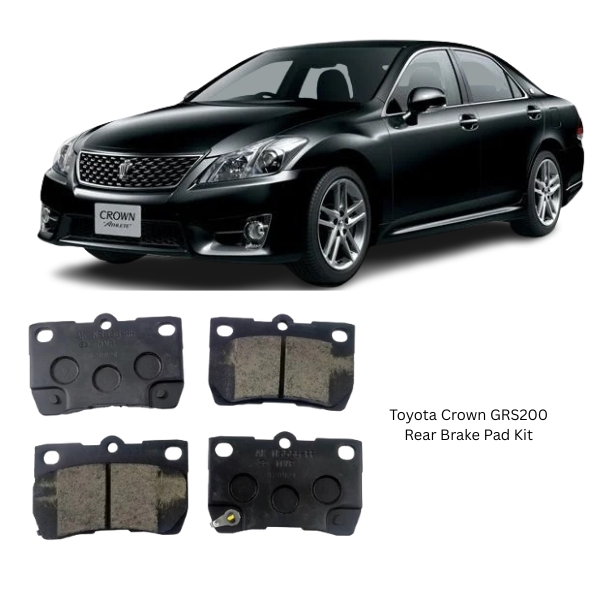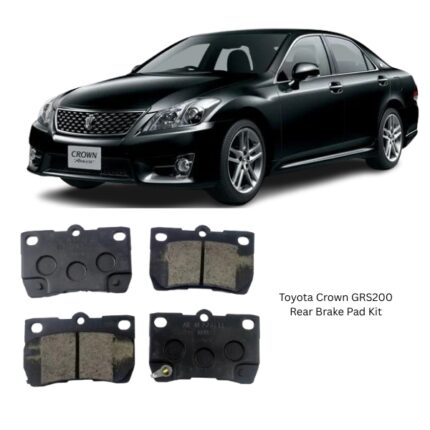Get Toyota Crown GRS200 Rear Brake Pad Kit D2243 in Kenya
The Rear Brake Pad Kit is a crucial part of the disc braking system, specifically engineered to deliver safe, efficient, and reliable stopping power at the rear axle of a vehicle. While front brakes typically handle the majority of stopping force, the rear brake pads play a vital supporting role—ensuring vehicle stability, balanced deceleration, and effective emergency braking.
Modern brake pad kits are designed not only for performance but also for durability, quiet operation, and minimal maintenance. A complete rear brake pad kit provides all necessary components for replacing worn rear pads, restoring full braking performance, and preserving system integrity.
Construction and Components
A standard Rear Brake Pad Kit typically includes:
-
Brake Pads (Inner and Outer) – Two pairs of friction pads per axle, each consisting of a backing plate and a friction material layer.
-
Shims – Multi-layered plates (often rubber-coated) placed behind the brake pad to reduce vibration and brake noise.
-
Wear Sensors – Depending on the design, some kits include electronic or mechanical wear indicators.
-
Hardware Clips or Abutment Kits – Anti-rattle clips and caliper guides to secure the pad and ensure smooth movement.
-
Grease Packet (Optional) – High-temperature brake grease for lubricating slide pins and contact points.
Each component is engineered to OEM or higher specifications, ensuring compatibility, performance, and ease of installation.
Friction Material Types
The brake pad’s friction layer is critical to performance and lifespan. Rear brake pads are commonly made from:
-
Ceramic – Clean, quiet, and long-lasting; ideal for everyday driving and minimal dust generation.
-
Semi-Metallic – Made with metal fibers; offers better heat resistance and braking under heavy loads.
-
Low-Metallic NAO (Non-Asbestos Organic) – A blend of organic and metallic materials offering balanced performance.
Each type has specific benefits depending on driving conditions and desired performance characteristics.
Function and Role in the Braking System
Rear brake pads work in coordination with the brake caliper and rotor to slow down or stop the rear wheels during braking. Their roles include:
-
Assisting in Vehicle Deceleration – While front brakes do most of the work, rear brakes stabilize the vehicle and balance braking force.
-
Supporting Emergency Braking – During ABS or panic stops, rear pads contribute to preventing skidding and rear-end instability.
-
Engaging the Parking Brake – In some systems (especially with integrated electric parking brakes), the rear pads also hold the vehicle stationary.
-
Managing Weight Transfer – Rear brakes prevent excessive forward pitch and help maintain even chassis balance under load.
The effectiveness of rear brake pads contributes directly to overall braking performance, vehicle safety, and passenger comfort.
Advantages of a Quality Rear Brake Pad Kit
Installing a high-quality rear brake pad kit delivers numerous advantages:
-
Consistent Braking Performance – Optimized friction materials ensure dependable stopping power under all conditions.
-
Low Noise Operation – Premium pads and hardware minimize squealing or rattling during braking.
-
Reduced Brake Dust – Especially with ceramic options, resulting in cleaner wheels and lower maintenance.
-
Enhanced Rotor Life – Smooth, even wear reduces risk of rotor scoring or heat cracking.
-
Improved Safety – Balanced braking reduces the risk of rear-wheel lockup or instability during high-speed stops.
-
Simple Installation – Complete kits include all necessary hardware, reducing service time and ensuring proper fitment.
Whether you’re maintaining a daily driver or ensuring fleet reliability, using a complete rear brake pad kit ensures lasting results.
Signs That Rear Brake Pads Need Replacement
Rear brake pads typically wear slower than front pads, but still require periodic inspection. Signs of worn or failing rear brake pads include:
-
Squealing or Squeaking Noise – Often the first indicator that the pad wear indicators are contacting the rotor.
-
Grinding Sound – A metallic noise suggesting the friction material is completely worn, exposing the backing plate.
-
Dashboard Warning Lights – Some systems trigger a brake warning when sensors detect low pad thickness.
-
Longer Stopping Distances – Diminished braking responsiveness, especially with increased load or speed.
-
Uneven Braking – Pulling, instability, or vehicle shuddering under braking.
-
Visible Pad Thickness – Pads less than 3mm thick should be replaced immediately.
Timely replacement of rear brake pads helps maintain safety and prevents damage to more expensive components like brake rotors and calipers.
Installation Guidelines
Proper installation ensures brake pad performance and longevity. General steps for replacing rear brake pads include:
-
Lift and Secure the Vehicle – Use jack stands and wheel chocks to safely access the rear wheels.
-
Remove Rear Wheels – Expose the caliper and rotor.
-
Detach Caliper and Old Pads – Unbolt the caliper and slide out the worn brake pads.
-
Inspect Components – Check the rotor surface, caliper piston, and slide pins for wear or damage.
-
Install New Hardware and Pads – Apply brake grease to contact points, replace anti-rattle clips, and install the new pads.
-
Compress Caliper Piston – Carefully reset the piston using a caliper tool to accommodate the thicker new pads.
-
Reassemble and Test – Reinstall the caliper and wheel, then test brake function before road use.
In systems with electronic parking brakes, it may be necessary to use a scan tool or follow a service procedure to disengage and recalibrate the mechanism.
Maintenance and Longevity Tips
To maximize the life of the rear brake pad kit:
-
Regular Inspections – Check pad thickness and wear pattern during routine service intervals.
-
Brake Fluid Health – Old or contaminated fluid can affect caliper pressure and rear braking performance.
-
Avoid Riding the Brakes – Excessive braking or dragging increases pad wear and heat stress.
-
Replace in Pairs – Always replace both rear pads together to maintain braking balance.
-
Keep Rotors Smooth – Replace or resurface rotors when pads are changed to prevent uneven wear or noise.
Rear brake pad life varies with driving habits, terrain, and vehicle load but generally lasts between 30,000 to 70,000 kilometers depending on use.
Environmental and Safety Considerations
Modern rear brake pads are increasingly manufactured with eco-friendly materials, avoiding heavy metals like copper and lead. These advancements reduce environmental impact and comply with global regulations.
In terms of safety, rear brakes are vital for preventing brake fade, particularly during prolonged descents or stop-and-go traffic. By maintaining rear pad integrity, drivers reduce the risk of overheating and maintain full braking power when it’s needed most.
Follow us on Facebook for more parts.




